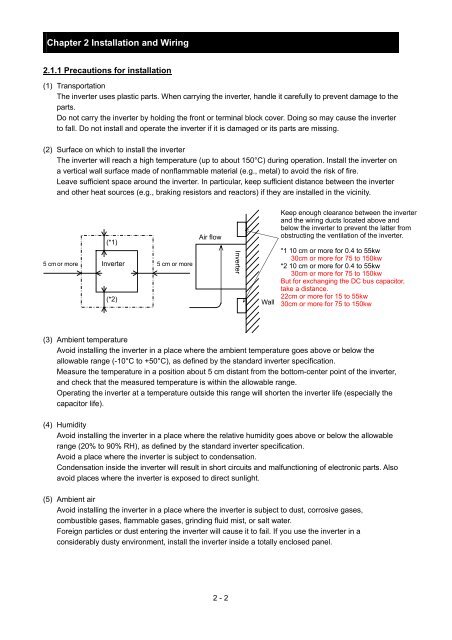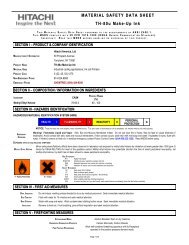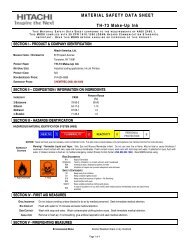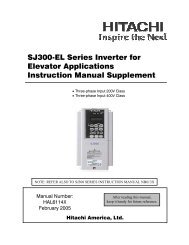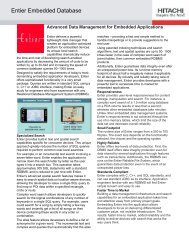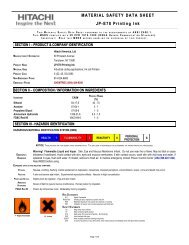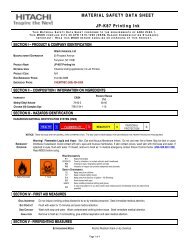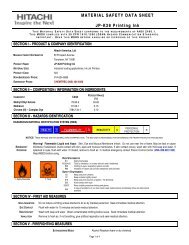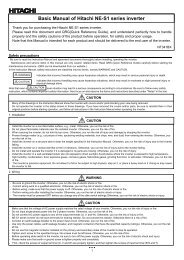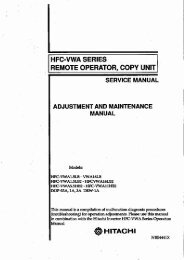- Page 1 and 2: HITACHI INVERTER SJ700-2 SERIES INS
- Page 3 and 4: Safety Instructions Safety Instruct
- Page 5 and 6: Safety Instructions 3. Operation !
- Page 7 and 8: Safety Instructions Precautions Con
- Page 9 and 10: Safety Instructions Precautions Con
- Page 11 and 12: Safety Instructions 10. Distributio
- Page 13 and 14: Contents Chapter 1 Overview 1.1 Ins
- Page 15 and 16: Contents 4.2.30 Overload restrictio
- Page 17 and 18: Contents 4.3.15 Speed/position swit
- Page 19: Chapter 1 Overview This chapter des
- Page 22 and 23: Chapter 1 Overview 1.2 Method of In
- Page 24: Chapter 2 Installation and Wiring T
- Page 29 and 30: Chapter 2 Installation and Wiring 2
- Page 31 and 32: Chapter 2 Installation and Wiring 2
- Page 33 and 34: Chapter 2 Installation and Wiring D
- Page 35 and 36: Chapter 2 Installation and Wiring S
- Page 37 and 38: Chapter 2 Installation and Wiring c
- Page 39 and 40: Chapter 2 Installation and Wiring T
- Page 41 and 42: Chapter 2 Installation and Wiring T
- Page 43 and 44: Chapter 2 Installation and Wiring (
- Page 45 and 46: Chapter 2 Installation and Wiring 7
- Page 47 and 48: Chapter 2 Installation and Wiring (
- Page 49: Chapter 3 Operation This chapter de
- Page 52 and 53: Chapter 3 Operation You can operate
- Page 54 and 55: Chapter 3 Operation 3.2.2 Code disp
- Page 56 and 57: Chapter 3 Operation Key operation a
- Page 58 and 59: Chapter 3 Operation (3) Code/data d
- Page 60 and 61: Chapter 3 Operation 3.3 How To Make
- Page 62 and 63: Chapter 3 Operation ELB 3-phase pow
- Page 65 and 66: Chapter 4 Explanation of Functions
- Page 67 and 68: Chapter 4 Explanation of Functions
- Page 69 and 70: Chapter 4 Explanation of Functions
- Page 71 and 72: Chapter 4 Explanation of Functions
- Page 73 and 74: Chapter 4 Explanation of Functions
- Page 75 and 76:
Chapter 4 Explanation of Functions
- Page 77 and 78:
Chapter 4 Explanation of Functions
- Page 79 and 80:
Chapter 4 Explanation of Functions
- Page 81 and 82:
Chapter 4 Explanation of Functions
- Page 83 and 84:
Chapter 4 Explanation of Functions
- Page 85 and 86:
Chapter 4 Explanation of Functions
- Page 87 and 88:
Chapter 4 Explanation of Functions
- Page 89 and 90:
Chapter 4 Explanation of Functions
- Page 91 and 92:
Chapter 4 Explanation of Functions
- Page 93 and 94:
Chapter 4 Explanation of Functions
- Page 95 and 96:
Chapter 4 Explanation of Functions
- Page 97 and 98:
Chapter 4 Explanation of Functions
- Page 99 and 100:
Chapter 4 Explanation of Functions
- Page 101 and 102:
Chapter 4 Explanation of Functions
- Page 103 and 104:
Chapter 4 Explanation of Functions
- Page 105 and 106:
Chapter 4 Explanation of Functions
- Page 107 and 108:
Chapter 4 Explanation of Functions
- Page 109 and 110:
Chapter 4 Explanation of Functions
- Page 111 and 112:
Chapter 4 Explanation of Functions
- Page 113 and 114:
Chapter 4 Explanation of Functions
- Page 115 and 116:
Chapter 4 Explanation of Functions
- Page 117 and 118:
Chapter 4 Explanation of Functions
- Page 119 and 120:
Chapter 4 Explanation of Functions
- Page 121 and 122:
Chapter 4 Explanation of Functions
- Page 123 and 124:
Chapter 4 Explanation of Functions
- Page 125 and 126:
Chapter 4 Explanation of Functions
- Page 127 and 128:
Chapter 4 Explanation of Functions
- Page 129 and 130:
Chapter 4 Explanation of Functions
- Page 131 and 132:
Chapter 4 Explanation of Functions
- Page 133 and 134:
Chapter 4 Explanation of Functions
- Page 135 and 136:
Chapter 4 Explanation of Functions
- Page 137 and 138:
Chapter 4 Explanation of Functions
- Page 139 and 140:
Chapter 4 Explanation of Functions
- Page 141 and 142:
Chapter 4 Explanation of Functions
- Page 143 and 144:
Chapter 4 Explanation of Functions
- Page 145 and 146:
Chapter 4 Explanation of Functions
- Page 147 and 148:
Chapter 4 Explanation of Functions
- Page 149 and 150:
Voltage across main circuit termina
- Page 151 and 152:
Chapter 4 Explanation of Functions
- Page 153 and 154:
Chapter 4 Explanation of Functions
- Page 155 and 156:
Chapter 4 Explanation of Functions
- Page 157 and 158:
Chapter 4 Explanation of Functions
- Page 159 and 160:
Chapter 4 Explanation of Functions
- Page 161 and 162:
Chapter 4 Explanation of Functions
- Page 163 and 164:
Chapter 4 Explanation of Functions
- Page 165 and 166:
Chapter 4 Explanation of Functions
- Page 167 and 168:
Chapter 4 Explanation of Functions
- Page 169 and 170:
Chapter 4 Explanation of Functions
- Page 171 and 172:
Chapter 4 Explanation of Functions
- Page 173 and 174:
Chapter 4 Explanation of Functions
- Page 175 and 176:
Chapter 4 Explanation of Functions
- Page 177 and 178:
Chapter 4 Explanation of Functions
- Page 179 and 180:
Chapter 4 Explanation of Functions
- Page 181 and 182:
Chapter 4 Explanation of Functions
- Page 183 and 184:
Chapter 4 Explanation of Functions
- Page 185 and 186:
Chapter 4 Explanation of Functions
- Page 187 and 188:
Chapter 4 Explanation of Functions
- Page 189 and 190:
Chapter 4 Explanation of Functions
- Page 191 and 192:
Chapter 4 Explanation of Functions
- Page 193 and 194:
Chapter 4 Explanation of Functions
- Page 195 and 196:
Chapter 4 Explanation of Functions
- Page 197 and 198:
Chapter 4 Explanation of Functions
- Page 199 and 200:
Chapter 4 Explanation of Functions
- Page 201 and 202:
Chapter 4 Explanation of Functions
- Page 203 and 204:
Chapter 4 Explanation of Functions
- Page 205 and 206:
Chapter 4 Explanation of Functions
- Page 207 and 208:
Chapter 4 Explanation of Functions
- Page 209 and 210:
Chapter 4 Explanation of Functions
- Page 211 and 212:
Chapter 4 Explanation of Functions
- Page 213 and 214:
Chapter 4 Explanation of Functions
- Page 215 and 216:
Chapter 4 Explanation of Functions
- Page 217 and 218:
Chapter 4 Explanation of Functions
- Page 219 and 220:
Chapter 4 Explanation of Functions
- Page 221 and 222:
Chapter 4 Explanation of Functions
- Page 223 and 224:
Chapter 4 Explanation of Functions
- Page 225 and 226:
Chapter 4 Explanation of Functions
- Page 227 and 228:
Chapter 4 Explanation of Functions
- Page 230 and 231:
Chapter 5 Error Codes 5.1 Error Cod
- Page 232 and 233:
Chapter 5 Error Codes Name Gate arr
- Page 234 and 235:
Chapter 5 Error Codes 5.1.2 Option
- Page 236 and 237:
Chapter 5 Error Codes 3) Error indi
- Page 238 and 239:
Chapter 5 Error Codes 5.1.3 Trip co
- Page 240:
Chapter 6 Maintenance and Inspectio
- Page 243 and 244:
Chapter 6 Maintenance and Inspectio
- Page 245 and 246:
Chapter 6 Maintenance and Inspectio
- Page 247 and 248:
Chapter 6 Maintenance and Inspectio
- Page 250 and 251:
Chapter 7 Specifications 7.1 Specif
- Page 252 and 253:
Chapter 7 Specifications (3) Common
- Page 254 and 255:
Chapter 7 Specifications SJ700-150
- Page 256 and 257:
Chapter 7 Specifications SJ700-750
- Page 259 and 260:
Chapter 8 List of Data Settings 8.1
- Page 261 and 262:
Chapter 8 List of Data Settings 8.4
- Page 263 and 264:
Chapter 8 List of Data Settings AVR
- Page 265 and 266:
Chapter 8 List of Data Settings Oth
- Page 267 and 268:
Chapter 8 List of Data Settings Cod
- Page 269 and 270:
Chapter 8 List of Data Settings Cod
- Page 271 and 272:
Chapter 8 List of Data Settings Cod
- Page 273 and 274:
Chapter 8 List of Data Settings Cod
- Page 275 and 276:
Chapter 8 List of Data Settings Cod
- Page 277 and 278:
Appendix Upgrading from the SJ300 S
- Page 279 and 280:
Index A B C a/b....................
- Page 281 and 282:
Index O P O........................


